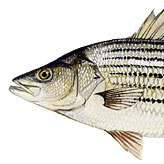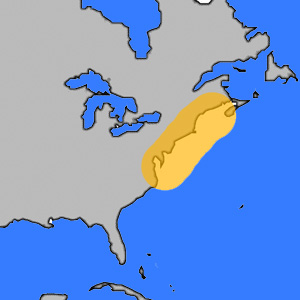General Information and Facts About Striped Bass Fishing
Striper’s most noticeable marking of dark bands running horizontally down their bodies gives them the name of striper or striped bass. It also makes them one of the most easy recognized fish when captured. The are silver in color with a blackish green top and white bottom with shades of silver in their midsection. They have a very large mouth capable of swallowing their prey head first with one swift gulp. They have very small if any teeth as they use the quick opening of their mouths to create a vacuum to suck in their meal. Stripers have an impressive tail which is generally almost as wide as their body height. Their dorsal fins have sharp needle like spines that will pierce the skin of an unexpected angler, so be careful when handling them. Striped bass generally do not grow much larger than 6 feet and 120 lbs. Larger ones have been captured, but they rarely get larger than this size. They are a school fish so if you catch one large striper you know that others are not far from your location.
Like trout and salmon they are a anadromous species, which means that they can live in both freshwater and saltwater. Stripers spend most of their adult life in saltwater and only head up freshwater inlets and streams to spawn. A majority of their breeding happens in the Chesapeake Bay and Hudson River. Many anglers argue about the exact locations of their spawning grounds, but some indicate the Connecticut River as well as areas of Delaware.
Striped Bass have a seasonal migration starting in northern Virginia all the way north to Nova Scotia. For this reason striper fishing has attendency to be the best in early spring and the late fall. I have found that when the water temperature reaches a magical 52 degrees fahrenheit the schoolie stripers (smaller stripers) start to arrive in Rhode Island. It is most likely the same case for the rest of the states along the east coast in the spring. In the fall they generally stick around until the water temperature drops below 50 degrees fahrenheit. The exact times and temperatures vary from year to year, but as I rule of thumb I don’t waist my time heading out before the water temperature rises above 50 degrees.
Many anglers argue as to if the Bluefish drive the Stripers away when they arrive after the water temperature reaches 58 degrees farienhieght. I personally have landed Stripers throughout the course of the year just using different techniques in the summer oppossed to the fall.
Stripers are strictly regulated as in the early 1980’s their populations were very low. Now their populations have rebounded back to what they were recorded back in the 1970’s. Their totals still do not measure up to what they were earlier in the century however. In many states their is a 2 fish limit of keeper size striped bass. Be sure to check your local state’s DEM website for updated fishing regulations.
They feed mostly at night or early morning so head out a few hours before sunrise to try your luck. Many anglers will make a night of fishing when they have the time. It is widely joked about that numerous divorces have happened due to the pursuit of these fish and I believe that their is much truth to these rumors.
They also are a very palatable fish. Look at our fishing receipies posts for some recipes to try.
Where to Catch Striped Bass
Stripers can be caught in a variety of locations along the east coast. In the spring when the water temperatures are around 52 degrees I have good luck along sandy shorelines in the northern portions of bays and inlets where the water runs a little warmer than at the mouth of the bay or inlet. The time of the season plays a major factor in deciding my location as in the summer when the water runs warmer I head for deeper waters by boat. Look for distinctions in the water where there is a large drop off. This can be noticed from the surface called a “Rip”. Bass will wait in drop off areas with running current ready to ambush an easy meal. Below are a listing of locations where you can find Stripers.
- Block Island
- Narragansett Bay
- Prudence Island
- Jamestown
- Martha’s Vineyard
- Nantucket
- Long Island
- Connecticut River
- Deleware Shoreline
- Deleware Bay
- Maryland
- Chesapeak Bay
How to Catch Striped Bass
There are numerous techniques you can use to land a lunker striped bass. In the spring I have attendacy to stick with soft plastic lures like “Storm Shad” or “Yum Lures”. I have also had good luck with freshwater plastic worms when on the pursuit of schoolies. Another technique that I learned from an “old salt” that is now a very popular method is using the “Tube and Worm” method. You can rig up a tube that resembles an eel and bait the end of it with a clam worms so it dangles off of the bottom. I generally troll at a very slow speed with an electric motor to get the lure down to the bottom where the Stripers are lurking. Fishing with live eels on a well lite night by a full moon should also generate some good results. They can be caught from the surf as well with surf casting rods on poppers or other hard surface bait. Fly Fishing for stripers in the surf using overgrown flies is also becoming a fast growing technique. If you are fishing deep water be sure to read our “What color fishing lure should I use” article to help you decide on the right color.
Another technique that is growing in popularity is looking for blitzing Bluefish and then sending a live pogie to the bottom fast (before the Bluefish get it) where the Stripers are waiting to pick up the scraps from the bluefish frenzy.
Some popular bait while on the pursuit of Stripers are clams, clam-worms, bunker, shad, mackerel, menhaden or pogies.
Some anglers will “live line” a butterfish or scup in deep water. Read this article to learn how to catch scup.
When to Catch Striped Bass
Generally as stated above you can catch Stripers all throughout the season, but the spring and fall generally produce the best results. Waiting for an incoming tide with a full moon is a good recipe for a successful fishing trip. Watch the water temperatures as I decide my trips based on temps rather than specific dates on a calendar.
Seven Tips to Catch Striped Bass
- Soft plastics lures in the spring
- Live bait in the fall
- Surface plugs in the beach throughout the summer on a moonlite night.
- Look for the working birds
- Research the “Worm Hatch”
- Find the artificial light near docks or marinas
- Find a local captain and have him put you on a “rip”
Striped Bass Fish Stories
In early spring along the Connecticut river I was fishing a small plastic eel off of the bottom hoping to land my first schoolie. Unfortunately I apparently was ill equipped as what grabbed my line was much more than a schoolie. It proceeded to scream the line of my lighter rod until I heard a snap of the end of my fishing line. I fished the same location the next day with the heaviest tackle I had at the time with no such luck. Lesson learned “Be prepared”.
I almost landed a 10 lb “stay over” striper on the rocks of upper Narraganset bay one winter. I was fishing with a tube and worm near the electric company (where the water runs warmer) when I reeled in a striper grabbed it with both hands and landed it on the rocks. I thought I had good footing, but apparently I did not as I feel backward into the water loosing by grip on the fish. When I pulled myself ashore nearly frozen my long sought after striper spit the hook and jumped back in to see another day.
One of my most memorable striper fishing experiences was fishing the “Rip” off the north side of Block Island using live eels with 4 ounce wieghts to get them down. We all landed our limit of fish all around 15 to 20lbs.


